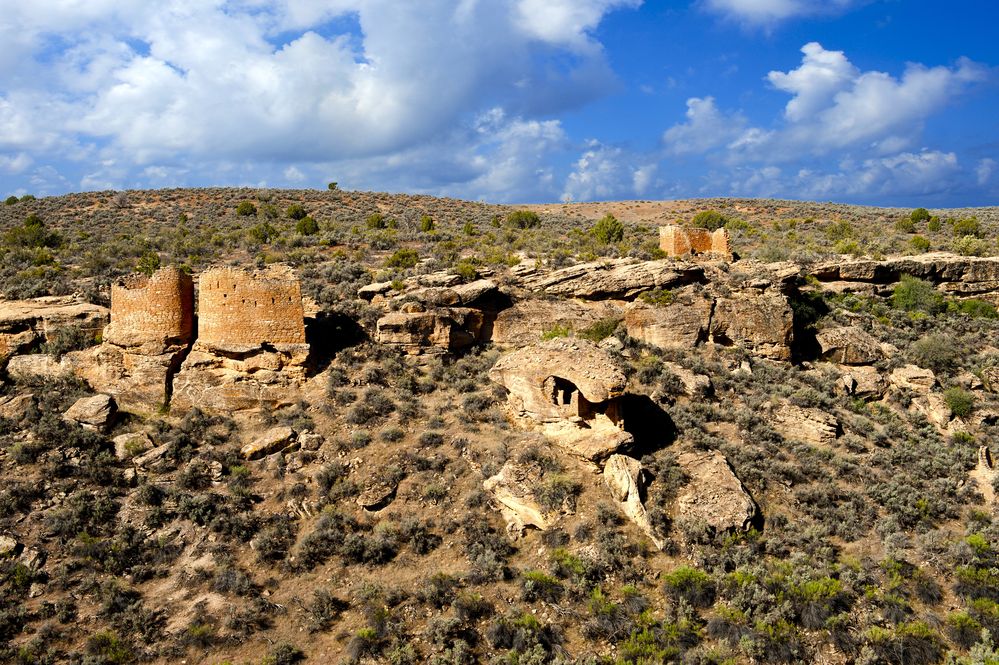Hovenweep National Monument preserves the remains of six prehistoric villages constructed between 1200 and 1300 AD that was once home to over 2,500 people. It is located in southwest Colordao and Southeastern Utah between Cortez and Blanding, Utah.

Location: Hovenweep National Monument is situated on the border between southeastern Utah and southwestern Colorado, encompassing a series of six prehistoric villages spread across the Cajon, Cutthroat Castle, Holly, Horseshoe, Hackberry, and Square Tower units. The monument is approximately 40 miles northeast of Bluff, Utah, and 45 miles west of Cortez, Colorado.
History: Hovenweep was established as a national monument on March 2, 1923, by President Warren G. Harding. The name “Hovenweep” is derived from the Ute/Paiute word for “deserted valley,” reflecting the area’s remote and secluded setting. The monument preserves the remains of ancestral Puebloan villages that were inhabited between A.D. 1200 and 1300, showcasing remarkable stone masonry and multi-story towers.
Why It’s Protected: Hovenweep National Monument is protected for its significant archaeological and cultural value. The well-preserved structures offer a glimpse into the ingenuity and architectural prowess of the ancestral Puebloan people. These ancient ruins provide valuable insights into the region’s prehistoric past and the way of life of its inhabitants. By protecting these sites, we ensure that future generations can continue to study and appreciate the cultural heritage of the ancestral Puebloans. The monument also preserves the natural landscape, which supports a diverse array of plant and animal species.
Things to Do: Visitors to Hovenweep National Monument can enjoy a variety of activities that highlight the area’s historical and natural beauty. Here are some highlights:
- Exploring the Ruins: Wander through the various units of Hovenweep to explore the ancient stone structures. Each unit offers a unique perspective on the architectural techniques and ingenuity of the ancestral Puebloans. The Square Tower Unit is the most accessible and features a well-maintained trail that leads to the impressive Square Tower and other ruins.
- Ranger Programs: Participate in ranger-led tours and educational programs to learn more about the history and significance of Hovenweep. These programs provide a deeper understanding of the monument’s archaeological sites and the people who once inhabited them.
- Hiking: Enjoy the scenic hiking trails that connect the different units of Hovenweep. The trails vary in length and difficulty, offering opportunities for both casual walkers and experienced hikers. The Holly Trail, for example, provides stunning views of the canyons and ruins.
- Wildlife Watching: Keep an eye out for the diverse wildlife that calls Hovenweep home, including mule deer, jackrabbits, and a variety of bird species. The monument’s protected habitats provide excellent opportunities for wildlife observation and photography.
- Photography: Capture the beauty of the ancient ruins and the surrounding desert landscape. The unique architecture and dramatic setting make for striking photographs, especially during the golden hours of sunrise and sunset.
- Stargazing: Hovenweep’s remote location and minimal light pollution make it an ideal spot for stargazing. On clear nights, visitors can enjoy breathtaking views of the night sky, with countless stars and celestial bodies on display.
Hovenweep National Monument is a testament to the ingenuity and resilience of the ancestral Puebloan people. Its well-preserved ruins, rich history, and stunning landscapes make it a great destination for history enthusiasts, nature lovers, and anyone seeking to connect with the ancient past.
Agate Fossil Beds
Aztec Ruins
Bandelier
Bears Ears
Cabrillo
Canyon de Chelly
Cedar Breaks
Colorado
Devils Postpile
Devils Tower
Dinosaur
Effigy Mounds
El Malpais
Florissant Fossil Beds
Fort McHenry
Fort Moultrie
Fort Pulaski
Fort Stanwix
Fort Sumter
George Washington Birthplace
Gila Cliff Dwellings
Grand Staircase-Escalante
Hovenweep
Lava Beds
Little Bighorn Battlefield
Misty Fjords
Montezuma Castle
Muir Woods
Natural Bridges
Ocmulgee
Organ Pipe Cactus
Pipestone
Pompeys Pillar
Rainbow Bridge
Russell Cave
Salinas Pueblo Missions
Scotts Bluff
Statue of Liberty
Sunset Crater Volcano
Tuzigoot
Vermilion Cliffs
White Sands
World War II Valor in the Pacific
Wupatki
